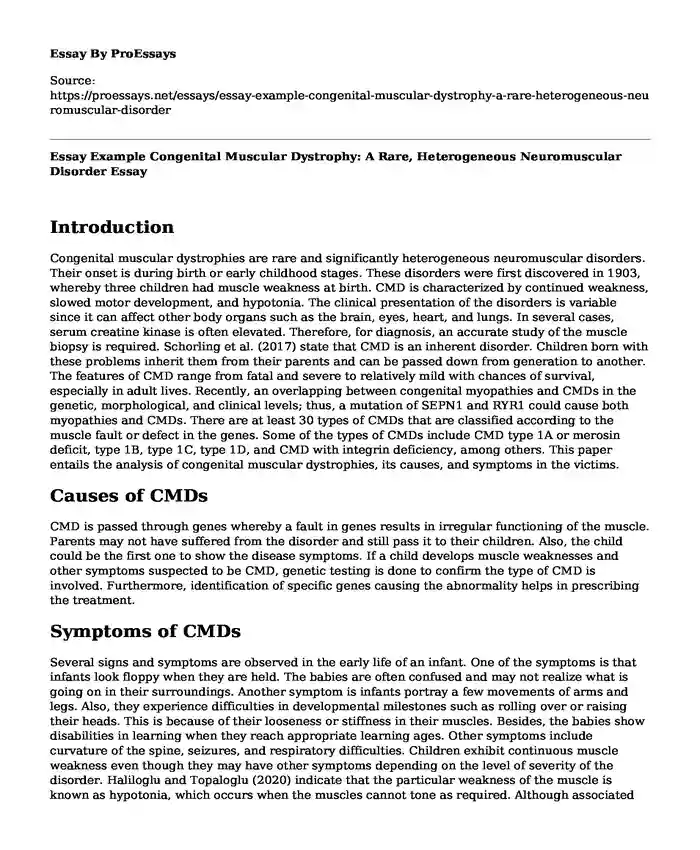Introduction
Congenital muscular dystrophies are rare and significantly heterogeneous neuromuscular disorders. Their onset is during birth or early childhood stages. These disorders were first discovered in 1903, whereby three children had muscle weakness at birth. CMD is characterized by continued weakness, slowed motor development, and hypotonia. The clinical presentation of the disorders is variable since it can affect other body organs such as the brain, eyes, heart, and lungs. In several cases, serum creatine kinase is often elevated. Therefore, for diagnosis, an accurate study of the muscle biopsy is required. Schorling et al. (2017) state that CMD is an inherent disorder. Children born with these problems inherit them from their parents and can be passed down from generation to another. The features of CMD range from fatal and severe to relatively mild with chances of survival, especially in adult lives. Recently, an overlapping between congenital myopathies and CMDs in the genetic, morphological, and clinical levels; thus, a mutation of SEPN1 and RYR1 could cause both myopathies and CMDs. There are at least 30 types of CMDs that are classified according to the muscle fault or defect in the genes. Some of the types of CMDs include CMD type 1A or merosin deficit, type 1B, type 1C, type 1D, and CMD with integrin deficiency, among others. This paper entails the analysis of congenital muscular dystrophies, its causes, and symptoms in the victims.
Causes of CMDs
CMD is passed through genes whereby a fault in genes results in irregular functioning of the muscle. Parents may not have suffered from the disorder and still pass it to their children. Also, the child could be the first one to show the disease symptoms. If a child develops muscle weaknesses and other symptoms suspected to be CMD, genetic testing is done to confirm the type of CMD is involved. Furthermore, identification of specific genes causing the abnormality helps in prescribing the treatment.
Symptoms of CMDs
Several signs and symptoms are observed in the early life of an infant. One of the symptoms is that infants look floppy when they are held. The babies are often confused and may not realize what is going on in their surroundings. Another symptom is infants portray a few movements of arms and legs. Also, they experience difficulties in developmental milestones such as rolling over or raising their heads. This is because of their looseness or stiffness in their muscles. Besides, the babies show disabilities in learning when they reach appropriate learning ages. Other symptoms include curvature of the spine, seizures, and respiratory difficulties. Children exhibit continuous muscle weakness even though they may have other symptoms depending on the level of severity of the disorder. Haliloglu and Topaloglu (2020) indicate that the particular weakness of the muscle is known as hypotonia, which occurs when the muscles cannot tone as required. Although associated with some of the rarest types of CMDs, mental retardation is experienced in some patients.
Conclusion
Congenital muscular dystrophies are gene-based disorders that may be passed from a parent to a child even if the parent does not have the symptoms. The disorders fall under various categories depending on the defect available in the genes. Consequently, varied symptoms are shown, which include hypotonia, floppiness, mental retardation, learning disabilities, slowed developmental milestones like walking, and rolling over. A gene testing is done to diagnose an infant that may show such symptoms.
References
Haliloglu, G., & Topaloglu, H. (2020). Evaluation of Congenital Muscular Dystrophies. https://n.neurology.org/content/evaluation-congenital-muscular-dystrophies
Schorling, D. C., Kirschner, J., & Bönnemann, C. G. (2017). Congenital Muscular Dystrophies and Myopathies: an Overview and Update. Neuropediatrics, 48(04), 247-261. https://www.thieme-connect.com/products/ejournals/html/10.1055/s-0037-1604154
Cite this page
Essay Example Congenital Muscular Dystrophy: A Rare, Heterogeneous Neuromuscular Disorder. (2023, Sep 27). Retrieved from https://proessays.net/essays/essay-example-congenital-muscular-dystrophy-a-rare-heterogeneous-neuromuscular-disorder
If you are the original author of this essay and no longer wish to have it published on the ProEssays website, please click below to request its removal:
- The Effects Maternal Depression on the Development of Young Children: Essay Sample
- Understand College Student Leadership Development - Critical Essay
- Problem Solution Essay on School's Computer Library
- View Points on the American Standardized Tests
- Essay Example on Sex: A Key to Enhancing Our Physical and Mental Health
- Essay Example on 2003 SARS Outbreak: How it Was Contained & Eradicated
- Wear Face Masks on Public Transport During Lockdown: TfL Warning - Essay Sample







